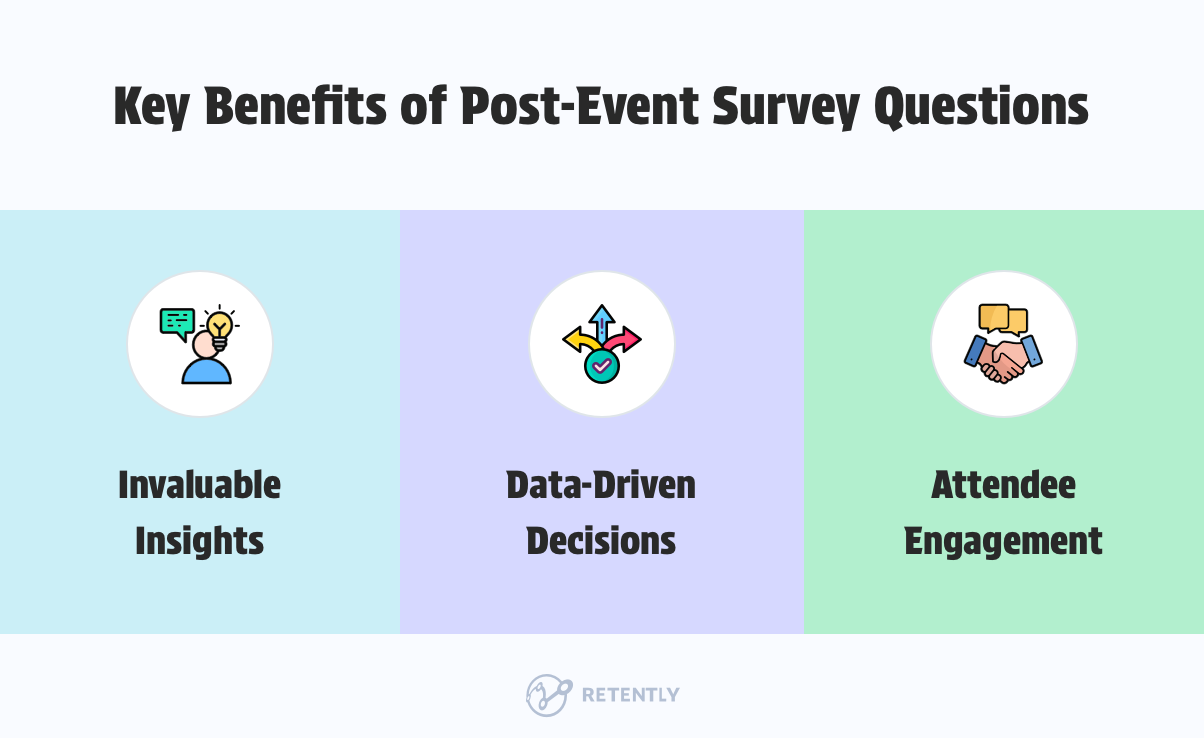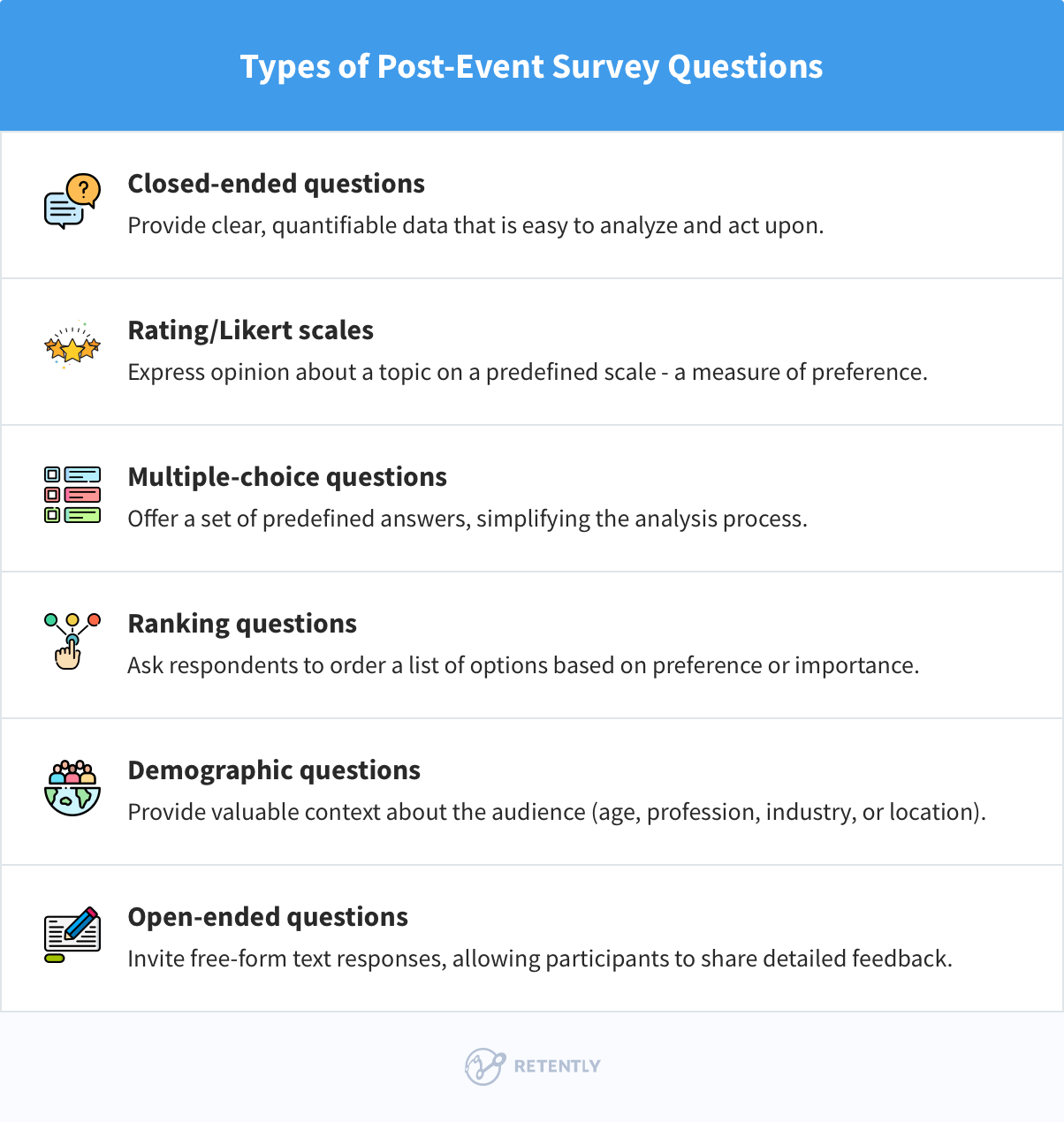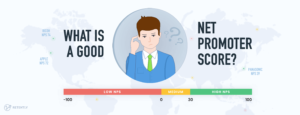Are you curious about the genuine reactions of your attendees after they experience your event? Post-event surveys are crucial for this feedback, but the real challenge is knowing the right questions to ask. In this guide, you’ll find why they are important, areas to focus on, and 35 essential post-event survey questions crafted to draw out the insights you need. From measuring satisfaction to understanding the effectiveness of each segment, these questions are your stepping stones to creating more impactful and memorable events.
Key Takeaways
- Post-event surveys are key to capturing attendee experience, gauging event success, and informing future event planning by offering insights into what aspects of the event were successful and what areas could be improved.
- A balanced mix of closed-ended and open-ended questions in post-event surveys is essential for collecting a comprehensive range of feedback, from quantitative data to qualitative insights.
- The effectiveness of post-event surveys is boosted by crafting questions that are short, focused, and clear, ensuring higher completion rates and data that is actionable for future events.
- Event success hinges on various factors like effective networking, content relevance, and the likelihood of attendees returning. To extract meaningful insights from your post-event survey questions, cover relevant aspects of the event experience.
Benefits of Deploying Post-Event Surveys
Imagine your latest event – a conference, or a virtual seminar – has just ended. While the immediate aftermath often involves a collective sigh of relief from event organizers and staff, the work is far from over. This is where the post-event survey steps in as a bridge between the just-concluded event to future successes.
Through a series of thoughtfully crafted survey questions, organizers can gather quantitative and qualitative data that shed light on the event’s impact. These surveys provide a platform for attendees to share their feedback, allowing organizers to understand what worked well and what could be tweaked.
Constructive feedback is key to improvement, and post-event survey questions are thus the perfect tools to understand attendee experience and measure event success. They capture their joys, frustrations, and valuable insights.
Yet, post-event surveys aren’t just about looking back – they’re key tools to inform future event planning. By shedding light on attendee expectations and experiences, these surveys offer invaluable insights, from gauging the impact of your marketing efforts to assessing the program’s appeal. Armed with this knowledge, you can tailor future events to ensure they hit the mark with attendees and continue to improve over time.

For that matter, let’s summarize the key benefits of post-event survey questions:
- Invaluable insights: They offer direct feedback from those who matter most – the attendees – providing clear indications of what worked well and what needs adjustments.
- Data-driven decisions: Post-event survey questions convert attendee experiences into actionable data, helping organizers make informed decisions to fine-tune every aspect of future events.
- Attendee engagement: They signal to attendees that their opinions are valued, building a sense of community and loyalty to your brand.
Types of Post-Event Survey Questions
Crafting surveys is a blend of creativity and methodical approach, where your choice of question types can significantly affect the outcome. Using a mix of these question formats equips you to gather a comprehensive understanding of experiences and perspectives from those taking part in your survey. The role each type plays contributes to the overall narrative in distinct ways, including:
Closed-Ended Questions
Closed-ended questions are fundamental for quantitative research, providing a measure of attendee satisfaction and experiences across different event aspects. They present participants with a predefined selection of answers, making it easier to categorize and analyze feedback on a broad scale. This question type is key for quickly gauging general sentiment and allows for easy comparison of data points, offering a clear and structured way to interpret opinions. Here are several types of questions part of the group:
1. Rating and Likert Scales
Rating scales or Likert scale offer a nuanced method for attendees to quantify their event experiences. These scales range from numerical ratings to descriptive terms, providing a simple way for attendees to express their satisfaction levels. The scales can help gauge the overall success of the event, attendee satisfaction with specific sessions or speakers, and the effectiveness of the event organization.
Hence, they’re particularly effective for evaluating specific aspects of an event, allowing organizers to pinpoint strengths and areas for improvement with precision. This feedback is instrumental in fine-tuning events to better cater to participant preferences and enhance the overall experience.
2. Multiple-Choice Questions
Multiple-choice questions streamline the feedback process, providing a set of clear options for respondents to choose from. This structure simplifies the response process for participants and accelerates the data analysis with straightforward data sets, allowing organizers to quickly identify patterns and preferences.
By asking attendees to choose from predefined options, you can efficiently gather information on specific aspects like the registration process, the effectiveness of the event app, or the quality of networking opportunities. Their versatility makes them key in various survey types, proving their worth in gathering post-event insights efficiently.
3. Ranking Questions
Ranking questions help understanding attendees’ priorities and preferences concerning different event aspects. By asking participants to order elements like Venue, Content, Speakers, and Networking Opportunities based on their importance, organizers gain insights into what attendees value most. This information is important for future event planning, as it helps organizers allocate resources and attention to the areas that matter most to their audience.
4. Demographic Questions
Incorporating demographic questions in post-event surveys, while not directly related to the event’s content, offers a broader understanding of the attendee profile. Questions about age, profession, industry, or geographic location help organizers paint a detailed picture of their audience. This demographic data is valuable for creating more targeted and relevant event experiences for different attendee segments.
Open-Ended Questions
On the flip side, while quantitative data is important, it’s the qualitative insights from open-ended questions that can offer the depth and context you need to truly understand your attendees’ experiences. These questions uncover unique insights and perspectives that might be missed otherwise, offering a deeper understanding of your event’s impact. They enable respondents to share their experiences in their own words, providing a space for nuanced feedback that can guide improvements for future events.

Crafting Effective Post-Event Survey Questions
An effective post-event survey hinges on question crafting. Ensure your questions are concise, focused, and balanced. Clarity and brevity are crucial to avoid overwhelming respondents and ensure high completion rates. Think of your survey as a guide, providing clear direction toward valuable insights that can refine future events.
Keep It Short and Focused
In survey design, less is often more. A brief customer feedback questionnaire respects the participant’s time and increases the likelihood of completion. Aim for focused questions that capture important feedback without overwhelming your respondents. A well-crafted survey efficiently collects crucial insights while ensuring a smooth experience for those providing input.
Balance Question Types
Your survey should act as a comprehensive tool, blending multiple-choice questions, rating scales, and open-ended inquiries to capture a wide range of data. This balanced approach allows you to collect both quantitative and qualitative insights, offering a detailed view of your event’s successes and areas for improvement. Ensuring a mix of question types will help you gather thorough feedback, providing a clear picture of attendee experiences to guide your strategies for future events.
Ensure Clarity and Relevance
In crafting survey questions, clarity is king. Avoid ambiguity and ensure each question is relevant and straightforward. Hence, your questions should be:
- precise
- customized for the specific event
- free from any potential misunderstanding
- aimed at gathering insights that can directly inform your efforts
Essential Post-Event Survey Questions to Focus on
With an understanding of the role of post-event surveys and effective question formulation, let’s now look into key areas to focus on and explore 35 post-event survey questions to consider. These questions span from overall event satisfaction to specific logistical aspects. Additionally, pre-event survey questions should not be overlooked, as they provide key insights for planning successful events. This set of questions is your toolkit for extracting valuable attendee input to shape more memorable and impactful future events.
General Event Satisfaction
Starting out, it’s important to evaluate the overall satisfaction with your event. It’s about understanding if attendees found value in the event or if there were areas that didn’t meet their expectations. These initial responses lay the groundwork for deeper analysis and offer a snapshot of your event’s potential long-term impact. A CSAT survey or an NPS survey question might be the perfect choice for this use case. A simple “How satisfied are you with the overall event experience?” or “On a scale of 0 to 10, how likely are you to recommend this event to a friend or colleague?” might do wonders.
Other questions you might use are:
- “How would you rate the value for money of the event?”
- “How well did the event align with your overall expectations?”
- “How likely are you to attend future events organized by us?”
- “How would you describe your overall experience at the event?”
- “Was there anything missing from the event that you expected to be included?”
Registration Process
The registration process is often the first touchpoint attendees have with your event, setting the tone for their overall experience. Was the registration process smooth and user-friendly? Did it provide attendees with all the necessary information? Gathering feedback on these initial interactions can help streamline your processes, making a positive first impression on future attendees.
Here are potential post-event survey questions relevant for this stage that you can use:
- “How would you rate the ease of the registration process?”
- “How helpful was the event information provided during registration?”
- “How satisfied were you with the communication received before the event?”
- “How would you rate the completeness of the information provided during the registration process regarding event logistics?”
- “How smoothly did the registration process go for you?”
Content and Presentations
Next, let’s delve into the core of any event: the content and presentations. Inquire about the relevance, quality, and delivery of the content presented at the event. Was the material engaging for your audience? Did it leave a lasting impression? Did the sessions align with attendees’ expectations and interests? It’s important to explore whether the topics discussed held the audience’s attention and left a lasting impression, providing educational and emotional value. This aspect of your survey helps you understand the depth of your event’s impact on attendees’ knowledge and engagement.
Use this input to refine your content curation process, selecting topics that align with attendee interests. Additionally, experiment with different formats and engagement strategies to keep your events dynamic and interactive. For example, if surveys indicate a high appreciation for Q&A sessions, consider incorporating more interactive segments into your event agenda.
Here are some example for consideration:
- “How relevant did you find the event content to your interests or industry?”
- “Was the event agenda well-structured?”
- “How would you rate the quality of the workshops?”
- “To what extent did the event fulfill your professional development expectations?”
- “Were the topics covered at the event timely?”
- “How effectively were the sessions paced throughout the event?”
- “Was there a good balance between different types of content (e.g., keynotes, panels, workshops)?”
- “How satisfied were you with the interactive elements of the event?”
Networking and Interaction
For many, networking is a primary motivation for attending events. Hence, networking is a vital aspect of events, including virtual ones, as it allows participants to engage in meaningful conversations and build new connections. It’s essential to assess the effectiveness of these networking opportunities: Did they facilitate meaningful interactions? Answering such queries can inform you on how to develop even more effective networking scenarios going forward. Here are some examples to explore:
- “How would you rate the networking opportunities provided at the event?”
- “Did the event facilitate meaningful connections with other attendees?”
- “Were there enough opportunities for interaction during the event?”
- “Did you find the networking sessions valuable for your professional growth?”
- “Was there a diverse mix of attendees to network with?”
- “How likely are you to follow up with contacts made during the event?”
Logistics and Venue
As event organizers, paying close attention to the finer points of logistics and venue selection is imperative. For physical venues, consider aspects like accessibility, layout, and amenities. For virtual events, evaluate the platform’s ease of use, interactivity features, and technical reliability. Focusing on these key practicalities can improve ease and comfort for those attending your event, as their experience often hinges upon such details. Understanding attendees’ experiences in these areas can inform better decisions for future venue or platform selection.
Here are a set of examples to take into account:
- “How would you rate the overall satisfaction with the event venue or virtual platform?
- “Was the venue/virtual platform easy to navigate?”
- “How satisfied were you with the technological capabilities of the venue or platform?”
- “Were you able to easily access and participate in the sessions?”
- “Did you encounter any technical issues during the event? If so, how effectively were they resolved?”
- “Was the sign-in or login process straightforward for the event platform?”
Feedback for Sponsors, Speakers, and Staff
Remember, it’s important to acknowledge the sponsors, speakers, and staff, who are integral to your event’s success. Were their contributions recognized, and did their experiences align with expectations? Assess attendees’ perceptions of the staff’s helpfulness and professionalism. For speakers, consider their effectiveness in delivering content, engaging the audience, and their expertise in the subject matter. This feedback is invaluable for recognizing standout contributors and identifying areas for training or improvement.
Gathering targeted feedback from these stakeholders help to strengthen future collaborations and event planning. Again, some examples to look into:
- “How would you rate the professionalism of the event staff?”
- “Were the event staff responsive to your needs?”
- “How knowledgeable did you find the speakers at the event?”
- “Were the speakers approachable and available for questions?”
- “Were there any staff members or speakers who particularly impressed you? Why?”
Leveraging Post-Event Survey Data
Gathering post-event survey data isn’t just about collecting responses; it’s about deep analysis and strategic implementation. This process transforms raw data into actionable insights, pinpointing your event’s strengths and areas for growth. Ultimately, the aim is to turn this information into practical measures that can improve every aspect of the overall event experience.
The first step in your analysis should be to look for patterns and common themes in customer feedback. This can involve quantitative analysis, like calculating average satisfaction scores, and qualitative analysis, such as identifying recurring comments or suggestions in open-ended responses.
Specialized survey tools are extremely helpful in this respect, putting at your disposal smart analysis and reporting functionalities. By recognizing what consistently resonates with success and spotting what regularly falls short, you can monitor performance over time and make knowledge-based choices that contribute to ongoing success in your events.
While all feedback can provide some level of insight, prioritizing feedback is crucial, as not all input holds the same value. For example, outliers can be individual experiences that don’t necessarily reflect the overall attendee experience. Focusing on aspects that greatly influence attendee satisfaction allows for smart resource allocation and and quantifiable improvements in your event’s success.
The true power of insights lies in their ability to motivate action. This means taking the common themes and significant points of feedback and considering how they can be applied to improve your next event. For example, if many attendees suggest more networking opportunities, you might consider adding networking breaks or dedicated networking events in your next conference. If there’s feedback on the effectiveness of the event page, explore ways to enhance its functionality or user experience.
Effectively presenting these insights and fostering a team-oriented approach to improvement ensures that the feedback is actively used, not just stored away. This proactive engagement with survey data is key in refining events and collaborative efforts for business growth.
Quick Wins
Here are a few golden rules to guide you through the process:
- Always follow up: Send post-event surveys promptly while the experience is fresh in attendees’ minds. Timely follow-up ensures higher response rates and more accurate feedback.
- Segment your data: Analyzing feedback from different attendee types (first-timers vs. repeat attendees, for example) can provide nuanced insights and help tailor experiences to various audience segments.
- Act on the feedback: Showing that attendee feedback has led to tangible changes improves the event experience and builds loyalty among your audience.
- Communicate changes: Inform past and potential attendees about the improvements made based on feedback. This can be a powerful marketing tool and an incentive for past attendees to return, knowing their input is valued and acted upon.
Conclusion
As an event organizer, you have the power to transform your events into ever-improving experiences that resonate with attendees. Adopt post-event survey as part of your planning cycle. Design them thoughtfully, analyze them thoroughly, and, most importantly, act on the insights you gather. This proactive approach will elevate the quality of your events and reinforce your commitment to your attendees.
As we wrap up our post-event survey questions exploration, remember that each question you ask is an opportunity to learn and grow. The feedback you receive is the raw material from which you can craft an even more spectacular event experience. Let your next event be informed by the voices of those who experience it. Use a CX survey platform like Retently, to automate collection and feedback interpretation in no time. Test it in a free trial to see it for yourself.

















 Christina Sol
Christina Sol 



 Greg Raileanu
Greg Raileanu 


